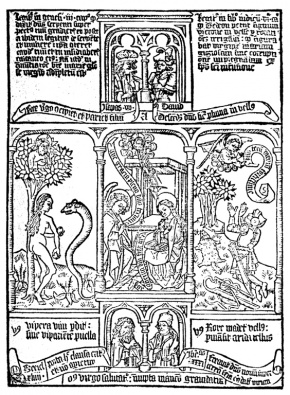Biblia pauperum
From Textus Receptus

The Biblia pauperum ("Paupers' Bible") was a tradition of picture Bibles beginning in the later Middle Ages. They sought to portray the historical books of the Bible visually. Unlike a simple "illustrated Bible", where the pictures are subordinated to the text, these Bibles placed the illustration in the centre, with only a brief text or sometimes no text at all. Words spoken by the figures in the miniatures could be written on scrolls coming out of their mouths. To this extent one might see parallels with modern cartoon strips.
The tradition is a further simplification of the Bible moralisée tradition, which was similar but with more text. Like these, the Bibliae Pauperum were usually in the local vernacular language, rather than Latin.
Originally they took the form of colourful hand-painted illuminated manuscripts on vellum, like the Velislai biblia picta, though in the fifteenth century printed examples with woodcuts took over. The Biblia pauperum was among the commonest works put out in block-book form, mainly in the Netherlands and Germany, where both text and images were done entirely in a single woodcut for each page. The first of many editions printed using movable type was printed in German, in Bamberg in about 1462; There were about eighteen incunabulum editions.<ref>ISTC British Library</ref> Bibliae pauperum were not intended to be bought by the poor — some manuscripts were opulent and very expensive, although the block-book versions were far cheaper, and probably affordable by parish priests. The simpler versions were however probably used by clergy as a teaching aid for those who could not read, which included most of the population. The name Biblia Pauperum was applied by German scholars in the 1930s.
A 15th century illuminated manuscript example known as the "Golden Bible" is in the British Library. It contains fifty pages and on each the central pictures of an event from the Gospels is accompanied by two slightly smaller picture of Old Testament events which prefigure the central one, according to belief of medieval theologians in typology. For example, the scene of Longinus spearing Jesus as he hangs on the Cross is accompanied by God bringing forth Eve from the side of Adam, and Moses striking the rock so that water flowed forth.<ref name = "fak">Faksimile.</ref>
The Biblia was rivalled by the Speculum Humanae Salvationis (Mirror of Human Salvation), another very popular compilation of typological pairings, with rather more text than the Biblia. The iconographical programmes of these books are shared with many other forms of medieval art, including stained glass windows and carvings of biblical subjects. Since books are more portable than these, they may well have been important in transmitting new developments in depicting the subjects. Most subjects, such as the Announcement to the Shepherds, can be seen in a very similar form at different dates, in different media and different countries.
References
| references-column-width
| references-column-count references-column-count-{{{1}}} }}
| {{#if:
| references-column-width }} }}" style="{{#if:
| {{#iferror: {{#ifexpr: 1 > 1 }}
| column-width: {{{1}}}; -moz-column-width: {{{1}}}; -webkit-column-width: {{{1}}};
| column-count: {{{1}}}; -moz-column-count: {{{1}}}; -webkit-column-count: {{{1}}}; }}
| {{#if:
| column-width: {{{colwidth}}}; -moz-column-width: {{{colwidth}}}; -webkit-column-width: {{{colwidth}}}; }} }}">
Unknown extension tag "references"- Golden Bible "Biblia Pauperum" 15th century – British Library, London, Kings MS 5
